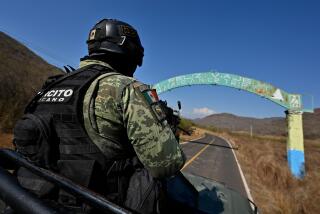U.S. Called on Honduras to Send Food, Arms to Contras
TEGUCIGALPA, Honduras — The United States has pressed the Honduran armed forces to supply logistical support to the Contras since Congress voted Feb. 3 to cut off aid to the rebels, according to a U.S. official, diplomats and sources close to the military.
Among the help that U.S. officials have sought is delivery of stockpiled weapons bought for the rebels last year with part of the previous $100-million U.S. aid package. The arms and ammunition reportedly are stored on one of the Swan Islands, off the Caribbean coast of Honduras, and at a military base on the mainland.
However, the Honduran Superior Council of the Armed Forces voted at a special meeting last month against U.S. requests to provide food, arms and other support to the Contras. According to one source, the council did so despite assurances that it would be reimbursed later for whatever it spent in the undertaking.
“The decision was that if the United States was not going to keep on helping the Contras, neither was Honduras,” a source with close ties to the armed forces here said.
The sources said two factors weighed in the military leaders’ decision.
First, since Honduras signed the Central American peace agreement last August, they did not want to risk being caught helping the Contras on their own, without direct U.S. involvement. The peace accord, signed by all five Central American presidents, prohibits any country from allowing rebels to use its territory to fight a neighboring country.
Secondly, with the U.S. aid cutoff, the military has begun to consider the likelihood of an end to the Contras’ 6-year guerrilla war against Nicaragua’s Sandinista government and to worry about its long-term relationship with the neighboring Sandinista Popular Army. The Sandinista army is larger, better equipped and “has no reason to be friendly to the Honduran military,” a Western diplomat said.
A military spokesman denied that the armed forces here were asked to aid the Contras. However, five sources acknowledged the existance of U.S. pressure and gave similar accounts of the meeting of the Superior Council. All spoke on condition that they not be identified.
Embassy Declines Comment
A U.S. Embassy spokesman declined to comment on what he called “private diplomatic discussions.”
But another U.S. official said in a telephone interview: “One of the assignments of our people (in Honduras) is to get the Hondurans to do whatever they can to help the Contras.”
He said that the Honduran military has in its possession “large parts of the old (military) aid” intended for the Contras, but he did not specify the amount of weapons or how much they might be worth. One source said there could be as much as $20-million worth.
“The question is, are they going to help move that stuff to where the Contras can get it? . . . We have asked the Hondurans for help repeatedly on this,” he said.
Under last year’s $100-million aid package, the CIA managed warehouses and ran supply flights for the Contras, using DC-6 aircraft operating from an airstrip in the Swan Islands. The islands also served as a support base during the CIA-backed invasion of Cuba at the Bay of Pigs in 1961.
Congress rejected official U.S. assistance to the Contras on Feb. 3, and because last year’s $100-million package expired Feb. 29, American officials have been barred from directly helping the rebels.
A new, $48-million aid package proposed in the Senate last week includes the expense to deliver stockpiled weapons.
The Honduran armed forces reportedly have not answered an American request to let the Contras use an airstrip on the Honduran mainland to operate supply flights to Contra units deployed inside Nicaragua.
The Swan Islands are relatively far from Nicaragua and, therefore, the flights are too expensive for the Contras to sustain on their own.
However, the Contras have access to at least one Spanish-made Caza aircraft--smaller than a DC-6--which they could use for aerial drops if they could operate out of an airstrip nearer to the Nicaraguan border, the sources said.
Renewed Concern
The aid cutoff, meanwhile, has renewed concern among military and civilian authorities here that Honduras may be saddled with an unemployed rebel army within its borders. When U.S. aid to the Contras was suspended in 1986, thousands of the Contras fled into Honduras and lived in base camps there until it was renewed.
“That is not a solution any more,” said Gilberto Goldstein, a congressman from the opposition Nationalist Party.
“People feel that the United States has a moral obligation, if it doesn’t choose to help the Contras any more, to remove them from the area or at least from Honduras,” Goldstein said.
The Contras’ presence in Honduras has been a source of controversy almost since the United States began to finance their war early in this decade. For years, the Honduran government officially denied that the rebels operated from Honduras, in spite of public protests by hundreds of farmers that Contras were trespassing on their land in areas near the border with Nicaragua.
Moved Base Camps
Last year, under strong pressure from the Honduran government, the rebels moved their base camps out of the so-called Las Vegas salient, a triangle of Honduran territory that juts south into Nicaragua about 90 miles east of Tegucigalpa.
The Contras opened a new base in Honduras about 50 miles farther northeast, across the Coco River from the Bocay River area of Nicaragua, where the Sandinistas conducted the most important thrust of their offensive against the Contras last week. The Swan Islands were chosen as the site of an aerial resupply base, largely to keep operations on behalf of the Contras out of the public eye in Honduras.
Last week’s incursion into Honduras by Sandinista soldiers pursuing retreating Contras prompted President Reagan to send 3,150 troops to Honduras for emergency deployment exercises. Some of the maneuvers are taking place 15 miles north of the Nicaraguan border but far to the west of the site of the Nicaraguan incursion.
The Honduran air force also bombed Nicaraguan targets on both sides of the border twice in retaliation for the incursion.
Pressed to Bomb Site
Western diplomatic sources said U.S. officials had pressed the Honduran air force to bomb a Sandinista military base at the town of Bonanza, about 45 miles inside Nicaragua. Instead, the Honduran warplanes limited their strikes to a zone that extended only about 5 miles south of the border.
The Honduran decision not to go deeper into Nicaragua came amid renewed sensitivity over the Contras’ presence in this country.
The border flare-up also refueled allegations here that the Reagan Administration deliberately exaggerated the scale of the Nicaraguan incursion to try to win new aid for the Contras.
Manuel Acosta Bonilla, a member of the Nationalist Party, noted that Washington condemned the incursion long before the Honduran government acknowledged publicly that it had happened.
“Washington knew the Contras were being destroyed (in the Sandinista offensive), and Reagan acted to save the Contras,” Acosta Bonilla said. “It is very sad how they play with a country in this way. They don’t even respect decorum, let alone the constitution.”
Times staff writer Doyle McManus contributed to this story from Washington.
Anti-Contra protesters seized in San Francisco. Page 18.
More to Read
Sign up for Essential California
The most important California stories and recommendations in your inbox every morning.
You may occasionally receive promotional content from the Los Angeles Times.










